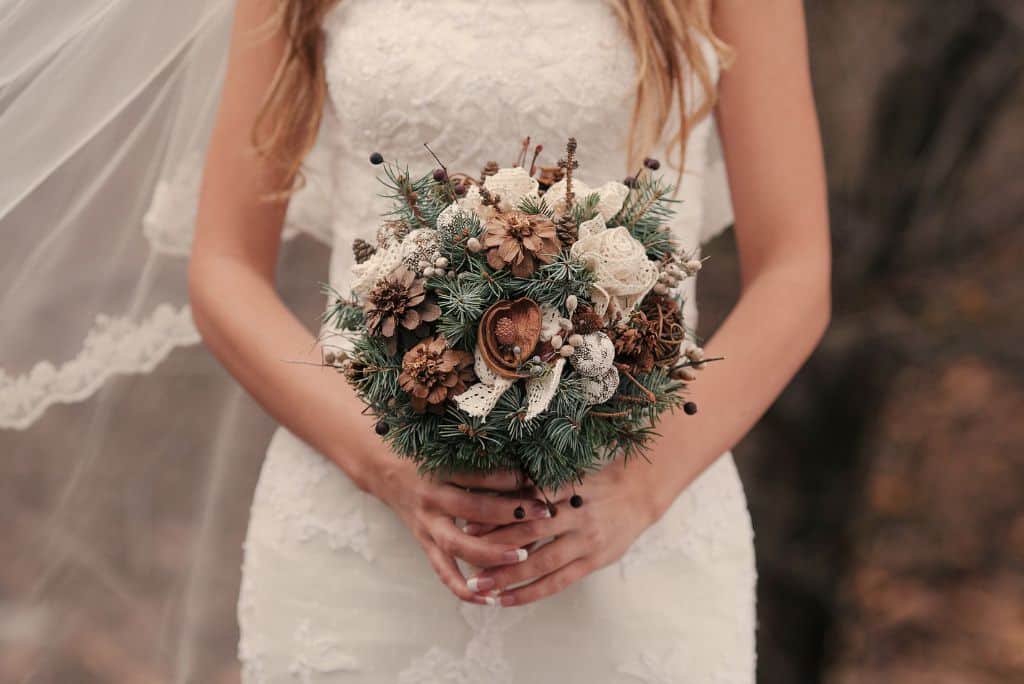Bridal bouquet is a flower arrangement carried by the bride down the aisle. It was designed to complement the wedding’s aesthetic and her dress.

A stunning bouquet is the icing on the cake of your bridal ensemble! However, have you ever pondered the significance of the bridal bouquet and why brides traditionally carry one?
The Demand for Bridal Bouquets
The custom calls for the bride to carry a bouquet throughout the ceremony. More specifically, have you ever considered the significance of bridesmaid bouquets? Like many other traditions, Bouquets have an illustrious past that can be traced back to antiquity.
- During Classical Greece
Spices and fresh herbs were often included in the bouquets that brides carried. Garlic was a standard component of fragrant bouquets of the time, though they also frequently included other aromatic plants. It was believed that the potent aroma given off by these bouquets would drive away any evil spirits that might have been wishing the newlyweds ill will.
- During Ancient Romans
They played a significant role in shaping contemporary wedding day customs, and they adopted this practice as well. The ancient Romans believed that a vein in this finger went straight to the heart, but this was a common myth. As a public declaration of their love for one another, they both wore wedding bands on those fingers.
- During Middle Ages
Even in the Middle Ages, it was customary to give flowers to the bride. Bouquets changed in form and function during this period, but spices and herbs continued to be used in place of flowers. Medieval women believed that the bouquets they carried with them not only offered protection from harm but also acted as a sort of aphrodisiac to promote fertility in the marriage.
- During the Victorian Era
Flowers instead of herbs and spices in bouquets became popular during the Victorian era in England during the 1800s. The first-ever bride to do so was Queen Victoria. She ditched the traditional bouquet of herbs and spices in favor of fresh flowers when she wed Prince Albert in 1840. Some speculated that this was done to mask body odor in the absence of deodorant, which was not widely available at the time.
Reason No. 1: To Hide the Bride’s Aroma
A dirty little secret about 15th-century brides is that they often smelled strongly of stale urine. As a result, they released a foul odor. The man of the house would be the first to enjoy a long soak in hot water, followed by any male members of the household, the lowly men and women who lived there, and finally, the child would be given the stale water that had been sitting around.
Reason No. 2: When Attempting to Exorcise Negative Energies.
Carrying a bridal bouquet as a talisman against evil spirits is ancient and widespread. In this case, the bouquets’ potent aroma was not due to the presence of flowers with a strong scent but rather to the inclusion of highly aromatic herbs like spices, dill, and possibly even a great deal of garlic and chives.
In other words, the bouquets didn’t have a foul odor because they weren’t made with flowers with a soft scent. Others have probably noticed the cooked potato making its way down the aisle.
It’s possible to approach this theory from two distinct perspectives. According to some schools of thought in traditional folklore, the potency of these odors serves as a sort of protection against evil spirits and misfortune. The people of the time tried to prolong their lives by placing cloves of garlic and dill over their noses and mouths because of the herbs’ natural medicinal properties.
Reason No. 3: To Arouse Passion in the Happy Couple
Roman wedding bouquets looked nothing like modern ones. As a symbol of renewal and fertility, flowers were used instead. Edible aphrodisiacs such as dill served a dual purpose, and marigolds were introduced to bouquets as the tradition of tossing the bouquet to the guests gained popularity again.
Reason No. 4: To Pass Along a Happy Message
This Victorian justification for carrying flowers at a wedding is probably similar to the modern reason people use today, that they signify something significant.
According to the principles of floriography, each flower variety carries a unique interpretation. These blossoms took extra weight during the Victorian era. A groom who wished to send a secret message of love to his bride would select a bouquet with flowers that conveyed his feelings. Flowers would be arranged in this fashion. The flowers used in a wedding ceremony are another way brides express their emotions to their future husbands.
Reason No. 5: To Express Love
This justification is more in line with how bridal bouquets are typically viewed nowadays. Flower messages were commonly exchanged between lovers in the Victorian era. Various meanings are ascribed to multiple flowers in the art of floriography.
Reason No. 6: To Secure the Bride
Guests at weddings a few centuries ago often tried to rip off a piece of the bride’s dress to bring some of the bride’s good fortune home with them. So, brides began tossing their bouquets into the crowd so that their eager guests would chase after the bouquets instead of the bride.
The bride and groom would quickly retreat to their bedroom to avoid being trampled whenever the bouquet was thrown around. Now that this novel practice has caught on, brides no longer need to worry about their guests ripping their dresses to shreds.
Conclusion
The bridal bouquet, with its rich history and deep symbolic meanings, is more than just an accessory to a bride’s ensemble; it is a testament to the enduring traditions that shape our celebration of love and union.
From its ancient roots as a protector against evil and a promoter of fertility, to its role in the Victorian era as a communicator of secret messages of affection, the bouquet has evolved to become a significant element of the wedding ceremony, imbued with beauty and meaning.
In today’s weddings, while the practical purposes of the bouquet may have shifted, its symbolic importance continues to flourish, serving as a poignant link between past and present, embodying the hopes, dreams, and love that are the essence of marriage.
As you plan your journey down the aisle, consider how these traditions can be woven into your own celebration. At Paradise Wedding Chapel, we specialize in crafting unforgettable Las Vegas weddings that honor your unique story and dreams.
Whether you’re drawn to the rich history of the bridal bouquet or seek to create new traditions of your own, our team is here to ensure your wedding day is as beautiful and meaningful as the love it celebrates.
Contact Paradise Wedding Chapel today to discover how we can help you succeed in creating a Las Vegas wedding that perfectly captures your spirit and style. Let us be a part of your love story, ensuring that every detail of your special day is nothing short of paradise.
FAQs
Why does the bride carry a bouquet at a wedding?
The bride carries a bouquet as a tradition that dates back to ancient times. It was originally done to ward off evil spirits, mask body odors, and symbolize fertility and happiness.
What did ancient bridal bouquets consist of?
Ancient bridal bouquets often consisted of herbs, spices, and garlic rather than flowers. These items were chosen for their ability to drive away bad spirits and promote health and fertility.
How did the tradition of carrying flowers start?
The tradition of carrying flowers began in the Victorian era, when Queen Victoria chose to carry a bouquet of fresh flowers instead of herbs and spices. This marked a shift towards floral bouquets as symbols of love and happiness.
What does the bridal bouquet symbolize today?
Today, the bridal bouquet symbolizes beauty, love, and the bride’s personal style. It also serves as a way to communicate through the language of flowers, where each type carries a specific meaning.
Can a bride choose not to carry a bouquet?
Yes, a bride can choose not to carry a bouquet if she prefers. The decision is entirely personal, and some brides opt for alternative options like books, lanterns, or even pets to reflect their unique style and preferences.
